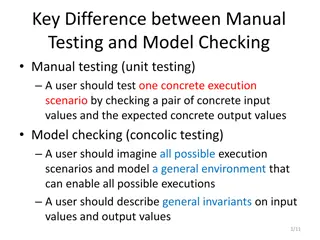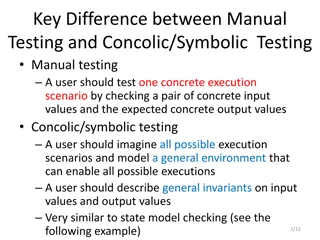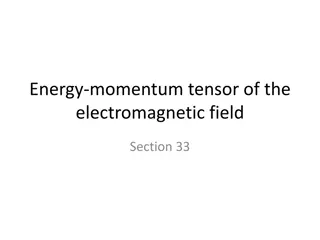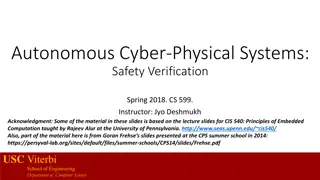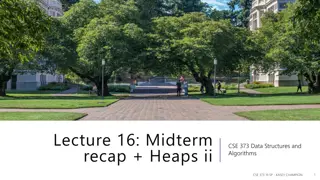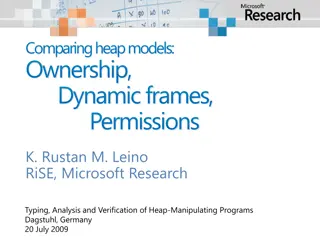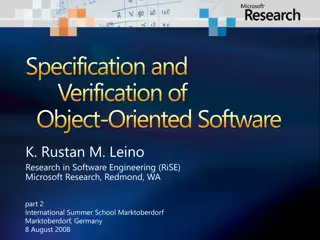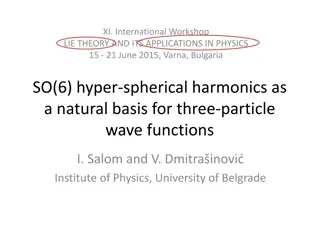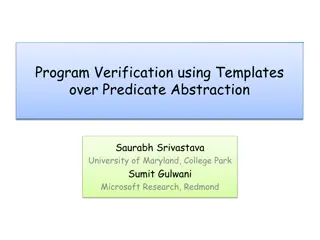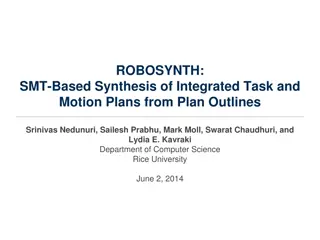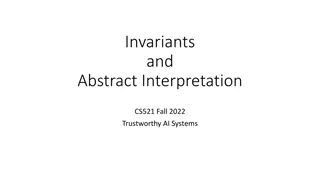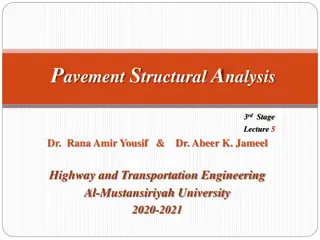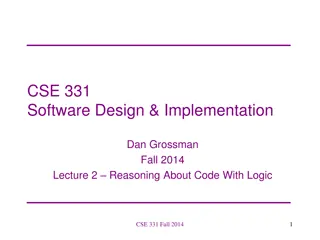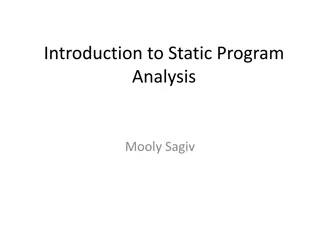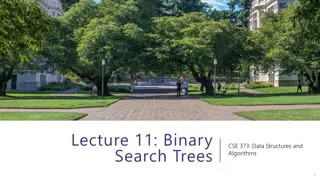Managing File System Consistency in Operating Systems
File systems in operating systems face challenges with crash consistency, especially during write operations. Issues arise when modified data in cache is lost due to system crashes or when data structure invariants are violated. Solutions like write-through and write-back caches help mitigate these
6 views • 14 slides
Overview of Distributed Systems: Characteristics, Classification, Computation, Communication, and Fault Models
Characterizing Distributed Systems: Multiple autonomous computers with CPUs, memory, storage, and I/O paths, interconnected geographically, shared state, global invariants. Classifying Distributed Systems: Based on synchrony, communication medium, fault models like crash and Byzantine failures. Comp
9 views • 126 slides
Understanding Stable Matchings and the Gale-Shapley Algorithm
The concept of stable matchings is explored, along with the Gale-Shapley algorithm for finding them efficiently. Key ideas and steps of the algorithm are explained, supported by visuals. The process, examples, and observations related to the algorithm's effectiveness are discussed, highlighting the
1 views • 29 slides
Difference Between Manual Testing and Model Checking
Manual testing focuses on testing specific scenarios with concrete inputs and outputs, while model checking involves imagining all possible scenarios to create a general environment for testing. In manual testing, users test specific execution scenarios, whereas in model checking, users envision and
2 views • 4 slides
Difference Between Manual Testing and Concolic/Symbolic Testing in Software Development
Manual testing involves checking concrete input and output values for specific execution scenarios, while concolic/symbolic testing requires imagining all possible scenarios and modeling a general environment. General invariants on input and output values are described, similar to state model checki
0 views • 4 slides
Understanding the Energy-Momentum Tensor of the Electromagnetic Field
Exploring the intricacies of the energy-momentum tensor of the electromagnetic field, including its components, symmetries, and implications on field interactions and invariants. Delve into the mathematical derivations and transformations involved in studying this fundamental concept in electromagne
0 views • 19 slides
Linearly Transformed Discretization Schemes for Plasma Simulations
Addressing the computational challenge of CO2 decomposition with plasmas, this study focuses on developing advanced discretization schemes and modern iterative linear solvers to ensure physical invariants are respected. The research explores the use of chemical invariants to simplify complex systems
0 views • 22 slides
Exploring C Program Refinement Types with Liquid Types and Invariant Discovery
Discover the integration of Liquid Types and Refinement Types in C programming through Invariant Discovery, leading to automatically adapting C programs to fit Liquid Types. Explore challenges and solutions in expressing invariants, handling unknown aliasing, and implementing strong updates within t
0 views • 24 slides
Comprehensive Overview of Midterm Review Topics in Data Structures and Object-Oriented Design
Covering topics such as run-time analysis, linear data structures, recursion, trees, priority queues, heaps, maps, hash tables, dictionaries, iterative algorithms, loop invariants, software engineering principles, and important functions in algorithm analysis.
0 views • 86 slides
Safety Verification Using Barrier Certificates in Autonomous Cyber-Physical Systems
Safety verification in autonomous cyber-physical systems involves the use of barrier certificates, which act as safety invariants for continuous dynamical systems. These certificates establish invisible barriers that trajectories cannot cross, ensuring system safety. By defining strict barrier condi
1 views • 21 slides
Implementing Heaps: Node Operations and Runtime Analysis
Understanding the implementation of heaps involves knowing various node operations like finding the minimum node, last node, next open space, children, and parent. The runtime analysis of heap operations such as peekMin, removeMin, and insert are crucial for optimizing performance. This recap covers
0 views • 9 slides
A Comparative Analysis of Heap Specification Approaches
This presentation discusses various approaches to heap specification, including ownership systems, dynamic frames, permissions, and capabilities. It explores challenges related to invariants and frames, showcasing examples from RockBand and Object state specifications. The discussion covers tools li
0 views • 11 slides
Specification and Verification of Object-Oriented Software in Research and Education
Explore the principles and methods for specifying and verifying object-oriented software, covering concepts like loop invariants, termination conditions, mutual exclusion, procedures, and more.
0 views • 25 slides
Coding Concepts Overview
This content covers a variety of coding concepts including image objects, git pull, method declaration and definition, algorithm implementation, handling Dafny output errors, and recursion. The discussions range from utilizing schema.org for structuring data to implementing recursive functions such
0 views • 9 slides
Applications of Hyper-Spherical Harmonics in Physics
Explore the utility of hyper-spherical harmonics as a natural basis for solving three-particle wave functions in physics, specifically in areas such as atomic physics, molecular physics, and systems involving three quarks. Learn about their role in reducing the complexity of problems, providing mani
0 views • 28 slides
Program Verification Using Templates Over Predicate Abstraction
This research explores a technique that allows for inferring invariants with arbitrary quantification and boolean structure, improving the state-of-the-art in program verification. It can infer weakest preconditions, helping with debugging and analysis by discovering worst-case inputs and missing pr
0 views • 32 slides
ROBOSYNTH: SMT-Based Synthesis of Integrated Task and Motion Plans
The ROBOSYNTH system aims to facilitate the creation of task plans that are feasible at the motion level by integrating task and motion planning. It provides a structured approach to generating plans, considering constraints on robot paths. The system employs a C program with defined actions and con
1 views • 25 slides
Understanding Invariants and Abstract Interpretation in Trustworthy AI Systems
Invariants and Abstract Interpretation are crucial concepts in building trustworthy AI systems. This involves defining configurations, concrete semantics, set semantics, and handling programs with loops. Monotonic functions play a vital role in ensuring consistency in the interpretation of these sys
0 views • 22 slides
Nonlinear Analysis of Pavement Structural Stresses and Deflections
Explore the effect of nonlinearity in granular materials on vertical stresses and deflections in pavement structural analysis. Learn about iterative methods and stress invariants to understand pavement behavior under traffic loads. Discover the application of Boussinesq's solutions and Burmister's l
0 views • 20 slides
Foundations of Concurrent Program Verification
Explore the importance of program verification methodologies, modular verification, and specification styles in ensuring the correctness of concurrent programs. Learn about key concepts like pre- and postconditions, loop invariants, and the role of specifications in bug detection and testing.
0 views • 35 slides
Logical Reasoning in Software Design and Implementation
Logical reasoning in software development involves determining the truth of facts as a program runs under specific assumptions. This process complements testing by allowing programmers to reason about classes of inputs/states and verify program correctness. Hoare Logic is introduced as a method for
0 views • 35 slides
Understanding Static Program Analysis
Static program analysis involves proving correctness, inferring invariants, and detecting errors in code before execution. Challenges include specifying program behavior, writing loop invariants, and using decision procedures for implications. This analysis can help ensure code reliability and ident
0 views • 73 slides
Understanding Binary Search Trees in Data Structures
Explore the concept of binary search trees (BST) in data structures, covering topics such as tree structure, node relationships, tree height calculation, BST invariants, and the recursive application of BST ordering. Learn how BSTs follow specific rules to maintain efficient searching and storing of
0 views • 46 slides



